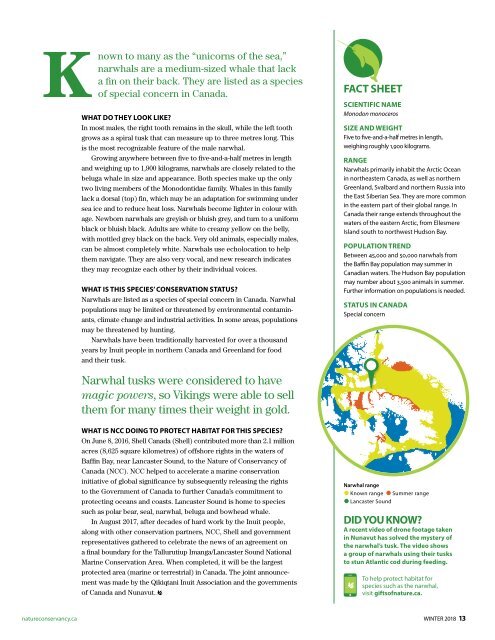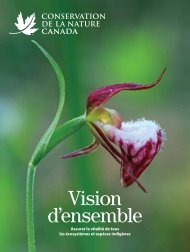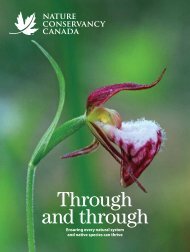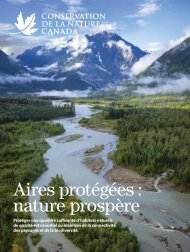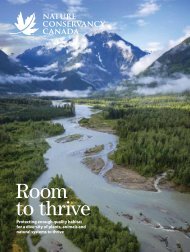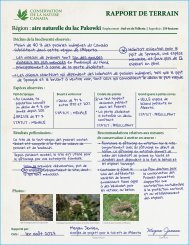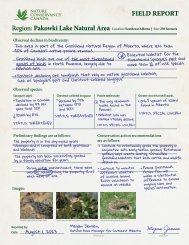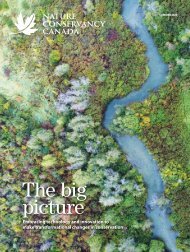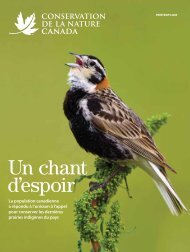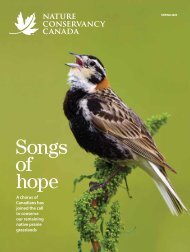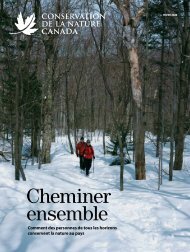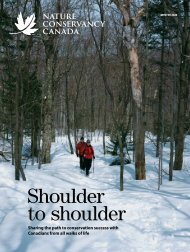Winter 2018 NCC magazine
Create successful ePaper yourself
Turn your PDF publications into a flip-book with our unique Google optimized e-Paper software.
Known to many as the “unicorns of the sea,”<br />
narwhals are a medium-sized whale that lack<br />
a fin on their back. They are listed as a species<br />
of special concern in Canada.<br />
WHAT DO THEY LOOK LIKE?<br />
In most males, the right tooth remains in the skull, while the left tooth<br />
grows as a spiral tusk that can measure up to three metres long. This<br />
is the most recognizable feature of the male narwhal.<br />
Growing anywhere between five to five-and-a-half metres in length<br />
and weighing up to 1,900 kilograms, narwhals are closely related to the<br />
beluga whale in size and appearance. Both species make up the only<br />
two living members of the Monodontidae family. Whales in this family<br />
lack a dorsal (top) fin, which may be an adaptation for swimming under<br />
sea ice and to reduce heat loss. Narwhals become lighter in colour with<br />
age. Newborn narwhals are greyish or bluish grey, and turn to a uniform<br />
black or bluish black. Adults are white to creamy yellow on the belly,<br />
with mottled grey black on the back. Very old animals, especially males,<br />
can be almost completely white. Narwhals use echolocation to help<br />
them navigate. They are also very vocal, and new research indicates<br />
they may recognize each other by their individual voices.<br />
WHAT IS THIS SPECIES’ CONSERVATION STATUS?<br />
Narwhals are listed as a species of special concern in Canada. Narwhal<br />
populations may be limited or threatened by environmental contaminants,<br />
climate change and industrial activities. In some areas, populations<br />
may be threatened by hunting.<br />
Narwhals have been traditionally harvested for over a thousand<br />
years by Inuit people in northern Canada and Greenland for food<br />
and their tusk.<br />
FACT SHEET<br />
SCIENTIFIC NAME<br />
Monodon monoceros<br />
SIZE AND WEIGHT<br />
Five to five-and-a-half metres in length,<br />
weighing roughly 1,900 kilograms.<br />
RANGE<br />
Narwhals primarily inhabit the Arctic Ocean<br />
in northeastern Canada, as well as northern<br />
Greenland, Svalbard and northern Russia into<br />
the East Siberian Sea. They are more common<br />
in the eastern part of their global range. In<br />
Canada their range extends throughout the<br />
waters of the eastern Arctic, from Ellesmere<br />
Island south to northwest Hudson Bay.<br />
POPULATION TREND<br />
Between 45,000 and 50,000 narwhals from<br />
the Baffin Bay population may summer in<br />
Canadian waters. The Hudson Bay population<br />
may number about 3,500 animals in summer.<br />
Further information on populations is needed.<br />
STATUS IN CANADA<br />
Special concern<br />
Narwhal tusks were considered to have<br />
magic powers, so Vikings were able to sell<br />
them for many times their weight in gold.<br />
WHAT IS <strong>NCC</strong> DOING TO PROTECT HABITAT FOR THIS SPECIES?<br />
On June 8, 2016, Shell Canada (Shell) contributed more than 2.1 million<br />
acres (8,625 square kilometres) of offshore rights in the waters of<br />
Baffin Bay, near Lancaster Sound, to the Nature of Conservancy of<br />
Canada (<strong>NCC</strong>). <strong>NCC</strong> helped to accelerate a marine conservation<br />
initiative of global significance by subsequently releasing the rights<br />
to the Government of Canada to further Canada’s commitment to<br />
protecting oceans and coasts. Lancaster Sound is home to species<br />
such as polar bear, seal, narwhal, beluga and bowhead whale.<br />
In August 2017, after decades of hard work by the Inuit people,<br />
along with other conservation partners, <strong>NCC</strong>, Shell and government<br />
representatives gathered to celebrate the news of an agreement on<br />
a final boundary for the Tallurutiup Imanga/Lancaster Sound National<br />
Marine Conservation Area. When completed, it will be the largest<br />
protected area (marine or terrestrial) in Canada. The joint announcement<br />
was made by the Qikiqtani Inuit Association and the governments<br />
of Canada and Nunavut.1<br />
Narwhal range<br />
•<br />
Known range • Summer range<br />
Lancaster Sound<br />
DID YOU KNOW?<br />
A recent video of drone footage taken<br />
in Nunavut has solved the mystery of<br />
the narwhal’s tusk. The video shows<br />
a group of narwhals using their tusks<br />
to stun Atlantic cod during feeding.<br />
To help protect habitat for<br />
species such as the narwhal,<br />
visit giftsofnature.ca.<br />
natureconservancy.ca<br />
WINTER <strong>2018</strong> 13


